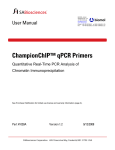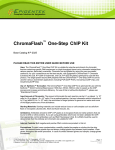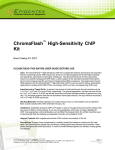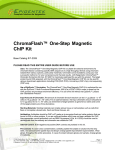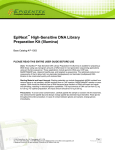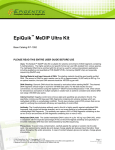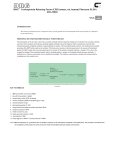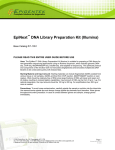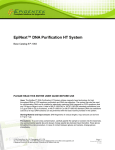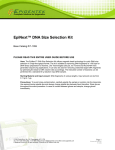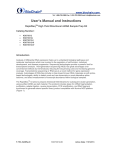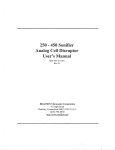Download ChromaFlash ™ Chromatin Isolation & Shearing Kit
Transcript
EPIGENTEK Complete Solutions for Epigenetics ChromaFlash™ Chromatin Isolation & Shearing Kit Base Catalog # P-2023 PLEASE READ THIS ENTIRE USER GUIDE BEFORE USE Uses: The ChromaFlash™ Chromatin Isolation & Shearing Kit is suitable for isolating and shearing chromatin from mammalian cells or tissues in a simple and rapid format. Chromatin sheared with this kit can be used in a variety of chromatin immunoprecipitation methods. The sheared chromatin can also be used in other chromatin-related applications such as in vitro protein-DNA binding assays. Starting Material and Input amount: Starting materials can include various tissue or cell samples such as cells from flask or microplate cultured cells, fresh and frozen tissues, etc. The amount of cells and tissues for each preparation can be 2 x 105 to 1 x 107 cells and 10 mg to 400 mg, respectively. For optimal preparation, the input amount should be 2 to 5 x 106 cells or 100 to 200 mg tissues. A total of 100 standard extractions (use 2 X106 cells or 100 mg of tissue per extraction) can be performed with this kit. The yield of sheared chromatin is approximately 3 µg per 106 cells or per 50 mg tissues. Precautions: To avoid cross-contamination, carefully pipette the sample or solution into the tube/vials. Use aerosol-barrier pipette tips and always change pipette tips between liquid transfers. Wear gloves throughout the entire procedure. In case of contact between gloves and sample, change gloves immediately. 110 Bi County Blvd. Ste. 122, Farmingdale, NY 11735 Tel: 1-877-374-4368 ■ Fax: 1-718-484-3956 ■ E-mail: [email protected] ■ Web: www.epigentek.com © Epigentek Group Inc. All rights reserved. Products are for research use only. Page 1 Printed 2014-09-22 P-2023 EPIGENTEK Complete Solutions for Epigenetics KIT CONTENTS Component 100 Preparations P-2023-100 Storage Upon Receipt 10X Lysis Buffer 11 ml RT Extraction Buffer 22 ml RT Chromatin Buffer 22 ml RT Protease Inhibitor Cocktails (1000X)* 110 µl 4°C User Guide 1 RT * Spin the solution down to the bottom prior to use. SHIPPING & STORAGE The kit is shipped on frozen ice packs at 4°C. Upon receipt: (1) Protease Inhibitor cocktails at 4°C; (2) Store remaining components at room temperature. All components of the kit are stable for 6 months from the date of shipment, when stored properly. Note: Check if any buffers contain salt precipitates before use. If so, shake the buffer until the salts are re-dissolved. MATERIALS REQUIRED BUT NOT SUPPLIED Sonicator Vortex mixer Dounce homogenizer Centrifuge including desktop centrifuge (up to 14,000 rpm) Pipettes and pipette tips 1.5 ml microcentrifuge tubes 15 ml conical tube Cells or tissues Cell culture medium 37% formaldehyde (if cross-linked) 1.25 M Glycine solution (if cross-linked) 1X PBS 110 Bi County Blvd. Ste. 122, Farmingdale, NY 11735 Tel: 1-877-374-4368 ■ Fax: 1-718-484-3956 ■ E-mail: [email protected] ■ Web: www.epigentek.com © Epigentek Group Inc. All rights reserved. Products are for research use only. Page 2 Printed 2014-09-22 P-2023 EPIGENTEK Complete Solutions for Epigenetics Distilled water GENERAL PRODUCT INFORMATION Quality Control: Each lot of the ChromaFlash™ Chromatin Isolation & Shearing Kit is tested against predetermined specifications to ensure consistent product quality. Epigentek guarantees the performance of all products in the manner described in our product instructions. Product Warranty: If this product does not meet your expectations, simply contact our technical support unit or your regional distributor. We also encourage you to contact us if you have any suggestions about product performance or new applications and techniques. Safety: Suitable lab coat, disposable gloves, and proper eye protection are required when working with this product. Product Updates: Epigentek reserves the right to change or modify any product to enhance its performance and design. The information in this User Guide is subject to change at any time without notice. Thus, only use the User Guide that was supplied with the kit when using that kit. Usage Limitation: The ChromaFlash™ Chromatin Isolation & Shearing Kit is for research use only and is not intended for diagnostic or therapeutic application. A BRIEF OVERVIEW Chromatin immunoprecipitaton (ChIP) offers an advantageous tool for studying protein-DNA interaction. The experimenter can determine if a specific protein binds to the specific sequences of a gene in living cells by combining ChIP with PCR (ChIP-PCR), microarray (ChIP-chip), or sequencing (ChIP-Seq) techniques. For example, the measurement of the amount of methylated histone H3 at lysine 9 (meH3-K9) associated with a specific gene promoter region under various conditions can be achieved through a ChIP-PCR assay, while recruitment of meH3-K9 to the promoters on a genomewide scale can be detected by ChIP-chip. In particular, the ChIP method with specific antibodies directly against various transcriptional factors is widely demanded. For performing ChIP, chromatin or DNA-protein complex in cells or tissues should first be isolated and sheared to desired size. The ChromaFlash™ Chromatin Isolation & Shearing Kit addresses the inconvenience and time consuming issues of existing chromatin preparation methods by introducing the following features: Fast procedure: the entire procedure from cell/tissue sample to ready-to-use sheared chromatin is less than 2 hours. Convenient and flexible: the kit is suitable for preparing both native chromatin and cross-linked chromatin from monolayer or suspension cells, or from tissues. Chromatin shearing is compatible with various sonication platforms including waterbath-based, probe-based sonicators and enzyme-based methods. PRINCIPLE & PROCEDURE The ChromaFlash™ Chromatin Isolation & Shearing Kit contains all reagents required for carrying out successful chromatin extraction and shearing directly from mammalian cells or tissues. Cell 110 Bi County Blvd. Ste. 122, Farmingdale, NY 11735 Tel: 1-877-374-4368 ■ Fax: 1-718-484-3956 ■ E-mail: [email protected] ■ Web: www.epigentek.com © Epigentek Group Inc. All rights reserved. Products are for research use only. Page 3 Printed 2014-09-22 P-2023 EPIGENTEK Complete Solutions for Epigenetics membranes of the sample, with or without cross-linking, are broken down using the provided lysis buffer. Chromatin or DNA-protein complex is then extracted with the extraction buffer. The extracted chromatin can then be sheared and stored at the appropriate temperature after being diluted in chromatin buffer. Chromatin was extracted from six MDA-231cell samples. 40 ul (8 ug) of chromatin were sheared in a 0.2 ml tube using the EpiSonic-1100 for 20 cycles (15 sec On and 30 sec Off). DNA was purified and then run on a gel. DNA recovery% 18 16 Sample 1 14 Sample 2 Sample 3 12 10 8 6 4 2 Schematic procedure of the ChromaFlash™ Chromatin Isolation/Shearing Kit 0 GAPDH MLH1 The sheared chromatin was used for ChIPqPCR analysis of RNA polymerase II enrichment in GAPDH and MLH1 promoters by using the ChromaFlash One-Step ChIP Kit (P2025) and the Methylamp™ MS-qPCR Fast Kit (P-1028). Assay Protocol For the best results, please read the protocol in its entirety prior to starting your experiment. Starting Materials Monolayer cells: 2x105 to 1x107 cells per preparation. Suspension cells: 4x105 to 2x107 cells per preparation. Tissues: 10 mg to 400 mg per preparation. 110 Bi County Blvd. Ste. 122, Farmingdale, NY 11735 Tel: 1-877-374-4368 ■ Fax: 1-718-484-3956 ■ E-mail: [email protected] ■ Web: www.epigentek.com © Epigentek Group Inc. All rights reserved. Products are for research use only. Page 4 Printed 2014-09-22 P-2023 EPIGENTEK Complete Solutions for Epigenetics 1. Preparation of Working Buffers and Solutions a. Prepare Working Lysis Buffer by adding 1 ml of 10X Lysis Buffer and 6 µl of Protease Inhibitor Cocktail to every 9 ml of distilled water. b. Prepare Working Extraction Buffer by adding 1 µl of Protease Inhibitor Cocktail to every 1 ml of Extraction Buffer 2. Cell Collection and Cross-Linking For Monolayer or Adherent Cells: a. Grow cells (treated or untreated) to 80%-90% confluence on a 100 mm plate (about 2x106 to 4x106 cells; 2x106 cells are required for each standard preparation), then trypsinize and collect them into a 15 ml conical tube. Count the cells in a hemocytometer. b. Centrifuge the cells at 1000 rpm for 5 min. Discard the supernatant. c. Wash cells with 10 ml of PBS once by centrifugation at 1000 rpm for 5 min. Discard the supernatant. Note: For cells that are not cross-linked, go directly to Step 3d after Step 2c. d. Add 9 ml fresh cell culture medium containing formaldehyde with a final concentration of 1% (i.e., add 270 µl of 37% formaldehyde to 10 ml of cell culture medium) to cells. e. Incubate at room temperature (20-25°C) for 10 min on a rocking platform (50-100 rpm). For Suspension Cells: a. Collect cells (treated or untreated) into a 15 ml conical tube. (2 x106 to 5x106 cells are required for each preparation). Count cells in a hemocytometer. b. Centrifuge the cells at 1000 rpm for 5 min. Discard the supernatant. c. Wash cells with 10 ml of PBS once by centrifugation at 1000 rpm for 5 min. Discard the supernatant. Note: For cells that are not cross-linked, go directly to Step 3d after Step 2c. d. Add 9 ml fresh cell culture medium containing formaldehyde with a final concentration of 1% (i.e., add 270 µl of 37% formaldehyde to 10 ml of cell culture medium) to cells. e. Incubate at room temperature (20-25°C) for 10 min on a rocking platform (50-100 rpm). For Tissues: a. Put the tissue sample into a 60 or 100 mm plate. Remove unwanted tissue such as fat and necrotic material from the sample. b. Weigh the sample and cut the sample into small pieces (1-2 mm3) with a scalpel or scissors. Note: For tissues that are not cross-linked, go directly to Step 2j after Step 2b. c. Transfer tissue pieces to a 15 ml conical tube. 110 Bi County Blvd. Ste. 122, Farmingdale, NY 11735 Tel: 1-877-374-4368 ■ Fax: 1-718-484-3956 ■ E-mail: [email protected] ■ Web: www.epigentek.com © Epigentek Group Inc. All rights reserved. Products are for research use only. Page 5 Printed 2014-09-22 P-2023 EPIGENTEK Complete Solutions for Epigenetics d. Prepare cross-link solution by adding formaldehyde to cell culture medium with a final concentration of 1%. (e.g., add 270 µl of 37% formaldehyde to 10 ml of culture medium). e. Add 1 ml of cross-link solution for every 50 mg tissues. f. Incubate at room temperature for 15-20 min on a rocking platform. g. Add 1 ml of 1.25 M glycine for every 9 ml of cross-link solution. h. Mix and centrifuge at 800 rpm for 5 min. Discard the supernatant. i. Wash cells with 10 ml of ice-cold PBS once by centrifugation at 800 rpm for 5 min. Discard the supernatant. j. Transfer tissue pieces to a Dounce homogenizer. k. Add 0.5 ml Working Lysis Buffer for every 50 mg tissues. l. Disaggregate tissue pieces by 20-40 strokes. m. Transfer homogenized mixture to a 15 ml conical tube and centrifuge at 3000 rpm for 5 min at 4°C. If total mixture volume is less than 2 ml, transfer mixture to a 2 ml vial and centrifuge at 5000 rpm for 5 min at 4°C. Then go directly to Step 3f. 3. Cell Lysis and Chromatin Extraction a. Add 1 ml of 1.25 M glycine for every 9 ml of cross-link solution. b. Mix and centrifuge at 1000 rpm for 5 min. c. Remove medium and wash cells once with 10 ml of ice-cold PBS by centrifuging at 1000 rpm for 5 min. d. Add Working Lysis Buffer to re-suspend the cell pellet (200 µl/1x106 cells) and incubate on ice for 10 min e. Vortex vigorously for 10 sec and centrifuge at 3000 rpm for 5 min. f. Carefully remove supernatant. g. Add Working Extraction Buffer to re-suspend the chromatin pellet (100 µl/1x106 cells, 500 µl maximum for each vial). h. Transfer the chromatin lysate to a 1.5 ml vial and incubate on ice for 10 min and vortex occasionally. 4. Chromatin Shearing a. Resuspend the chromatin lysate by vortexing. b. Shear chromatin with one of the following methods: Waterbath Sonication: 110 Bi County Blvd. Ste. 122, Farmingdale, NY 11735 Tel: 1-877-374-4368 ■ Fax: 1-718-484-3956 ■ E-mail: [email protected] ■ Web: www.epigentek.com © Epigentek Group Inc. All rights reserved. Products are for research use only. Page 6 Printed 2014-09-22 P-2023 EPIGENTEK Complete Solutions for Epigenetics Epigentek EpiSonic 1100 (Epigentek Cat No. EQC-1100): Use 50 ul of chromatin lysate per 0.2 ml tube or per PCR plate well. Shear 20 cycles, 15 sceond On, 30 second Off, each at 170-190 watts. Diagenode Bioruptor: Use 200 ul of chromatin lysate per 1.5 ml vial. Shear 3 runs of 10 cycles, 30 second On, 30 second Off, each at high power setting. Spin and vortex between each run. Covaris S2 Instrument: Use 130 ul of chromatin lysate per Covaris microTube. Duty cycle: 2%, Intensity: 3, Cycles per burst: 200, Total processing time: 10 min. Probe-based Sonication: Use 300 ul of chromatin lysate per 1.5 ml tube. As an example, sonication can be carried out with a microtip attached to a Branson 450 sonifier, set to 25% power output. Sonicate 3-4 pulses of 10-15 seconds each, followed by 30-40 seconds rest on ice between each pulse. (The conditions of cross-linked DNA shearing can be optimized based on cells and sonicator equipment). If desired, remove 10 µl of sonicated cell lysate for agarose gel analysis along with a DNA marker on a 1 - 2% agarose gel. Stain with Ethidium Bromide or other fluorescent dye for DNA and visualize it under ultraviolet light. The length of sheared DNA should be between 200-1000 bp. Note: The isolated chromatin can also be sheared with various enzyme-based methods. The optimization of the shearing conditions, for example enzyme concentration and incubation time, is needed in order to use enzyme-based methods. c. Centrifuge at 12,000 rpm at 4°C for 10 min. d. Transfer supernatant to a new vial. e. Add Chromatin Buffer at a 1:1 ratio (e.g., add 100 µl of Chromatin Buffer to 100 µl of supernatant). The chromatin solution can now be used immediately or stored at –80°C after aliquoting appropriately until further use. Avoid multiple freeze/thaw cycles. TROUBLESHOOTING Problem Possible Cause Suggestion Low yield of chromatin Insufficient amount of samples. To obtain the best results, the amount 6 of samples should be 2 to 5 x 10 cells or 100 to 200 mg tissues per ChIP reaction. Insufficient chromatin extraction. Ensure that all reagents have been added with the correct volume and in the correct order based on the sample amount. Check for sample lysis under microscope after the tissue/cell lysis step. Ensure that the cell or tissue species 110 Bi County Blvd. Ste. 122, Farmingdale, NY 11735 Tel: 1-877-374-4368 ■ Fax: 1-718-484-3956 ■ E-mail: [email protected] ■ Web: www.epigentek.com © Epigentek Group Inc. All rights reserved. Products are for research use only. Page 7 Printed 2014-09-22 P-2023 EPIGENTEK Complete Solutions for Epigenetics are compatible with this extraction procedure. Lysis or extraction reagents have expired. Expired reagents may cause inefficient extraction. Ensure that the kit has not exceeded the expiration date of the kit. Standard shelf life, when stored properly, is 6 months from date of receipt. Incorrect temperature and/or insufficient incubation time during extraction. Ensure the incubation time and temperature described in the protocol are followed correctly. Degradation of chromatin Improper storage of chromatin. Chromatin sample should be stored at –80°C (3-6 months). Avoid multiple freeze/thaw cycles. There is a cloudy layer in the sheared chromatin solution Lipid and glycogen are not completely removed during chromatin extaction. Avoid this layer when supernatant is removed. Chromatin is not efficiently sheared Shearing condition is not optimized, especially when probebased sonicator is used. To obtain desired DNA size (200-1000 bps), shear chromatin with a time course (ex: 5, 10, 15, 20 pulses) that generates suitably sized DNA for use in ChIP. In general, waterbath based sonicators, such as the EpiSonic-1100, could give consistent and efficient shearing conditions. RELATED PRODUCTS Chromatin Shearing and Cleanup P-1006 DNA Concentrator Kit Sonication Instruments EQC-1100 EpiSonic™ Multi-Functional Bioprocessor 1100 ChIP Reaction P-2025 ChromaFlash™ One-Step ChIP Kit P-2026 ChromaFlash™ One-Step Magnetic ChIP kit PCR Analysis P-1029 EpiQuik™ Quantitative PCR Fast Kit ChIP-Grade Antibodies For ChIP-Grade Antibodies, search “chip-grade” at www.epigentek.com 110 Bi County Blvd. Ste. 122, Farmingdale, NY 11735 Tel: 1-877-374-4368 ■ Fax: 1-718-484-3956 ■ E-mail: [email protected] ■ Web: www.epigentek.com © Epigentek Group Inc. All rights reserved. Products are for research use only. Page 8 Printed 2014-09-22 P-2023








